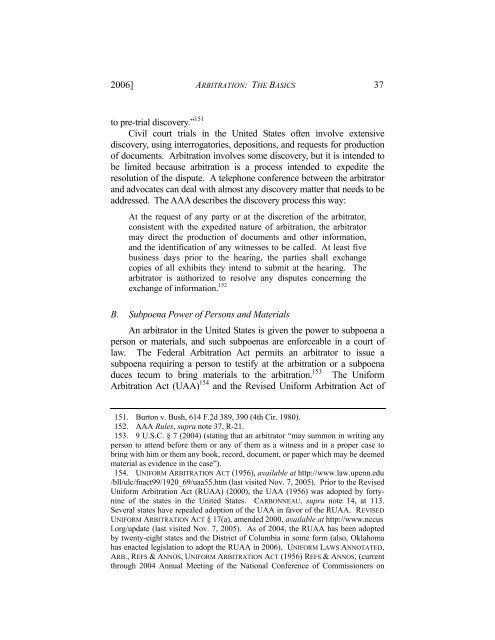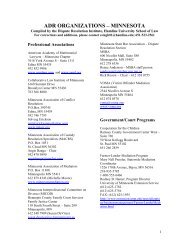2006/Vol. 5 No.1 - Hamline Law - Hamline University
2006/Vol. 5 No.1 - Hamline Law - Hamline University
2006/Vol. 5 No.1 - Hamline Law - Hamline University
Create successful ePaper yourself
Turn your PDF publications into a flip-book with our unique Google optimized e-Paper software.
<strong>2006</strong>] ARBITRATION: THE BASICS 37<br />
to pre-trial discovery.” 151<br />
Civil court trials in the United States often involve extensive<br />
discovery, using interrogatories, depositions, and requests for production<br />
of documents. Arbitration involves some discovery, but it is intended to<br />
be limited because arbitration is a process intended to expedite the<br />
resolution of the dispute. A telephone conference between the arbitrator<br />
and advocates can deal with almost any discovery matter that needs to be<br />
addressed. The AAA describes the discovery process this way:<br />
At the request of any party or at the discretion of the arbitrator,<br />
consistent with the expedited nature of arbitration, the arbitrator<br />
may direct the production of documents and other information,<br />
and the identification of any witnesses to be called. At least five<br />
business days prior to the hearing, the parties shall exchange<br />
copies of all exhibits they intend to submit at the hearing. The<br />
arbitrator is authorized to resolve any disputes concerning the<br />
exchange of information. 152<br />
B. Subpoena Power of Persons and Materials<br />
An arbitrator in the United States is given the power to subpoena a<br />
person or materials, and such subpoenas are enforceable in a court of<br />
law. The Federal Arbitration Act permits an arbitrator to issue a<br />
subpoena requiring a person to testify at the arbitration or a subpoena<br />
duces tecum to bring materials to the arbitration. 153 The Uniform<br />
Arbitration Act (UAA) 154 and the Revised Uniform Arbitration Act of<br />
151. Burton v. Bush, 614 F.2d 389, 390 (4th Cir. 1980).<br />
152. AAA Rules, supra note 37, R-21.<br />
153. 9 U.S.C. § 7 (2004) (stating that an arbitrator “may summon in writing any<br />
person to attend before them or any of them as a witness and in a proper case to<br />
bring with him or them any book, record, document, or paper which may be deemed<br />
material as evidence in the case”).<br />
154. UNIFORM ARBITRATION ACT (1956), available at http://www.law.upenn.edu<br />
/bll/ulc/fnact99/1920_69/uaa55.htm (last visited Nov. 7, 2005). Prior to the Revised<br />
Uniform Arbitration Act (RUAA) (2000), the UAA (1956) was adopted by fortynine<br />
of the states in the United States. CARBONNEAU, supra note 14, at 113.<br />
Several states have repealed adoption of the UAA in favor of the RUAA. REVISED<br />
UNIFORM ARBITRATION ACT § 17(a), amended 2000, available at http://www.nccus<br />
l.org/update (last visited Nov. 7, 2005). As of 2004, the RUAA has been adopted<br />
by twenty-eight states and the District of Columbia in some form (also, Oklahoma<br />
has enacted legislation to adopt the RUAA in <strong>2006</strong>). UNIFORM LAWS ANNOTATED,<br />
ARB., REFS & ANNOS, UNIFORM ARBITRATION ACT (1956) REFS & ANNOS, (current<br />
through 2004 Annual Meeting of the National Conference of Commissioners on
















